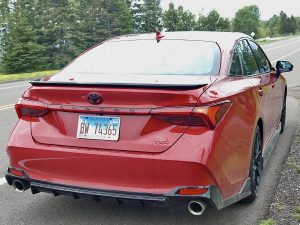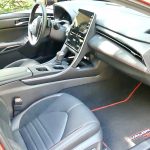Symbol of luxury, Avalon gets TRD spark
By John Gilbert
We can appreciate Toyota’s efforts to lift up some previously-boring sedans and give them a dose of performance, such as the Camry, Corolla, and even a couple of Lexus sedans, and we can celebrate the company’s producing some advanced platforms and even new engines as well as major alterations in its hybrid systems.
Throughout the corporate wide renovations, though, we could all take comfort in knowing there will always be an Avalon.
The Avalon has always been an interesting sedan, a stretched version of the popular Camry midsize car, but always loaded up with luxury features. In its lifetime, I always had the theory that since Toyota spun off Lexus as a separate brand for luxury versions of various Toyotas, the company’s preferred progression for customers was to start off with a Corolla, and after a couple of them, move up to a midsize Camry, and after a couple of them, move on into the Lexus brand for something a little more expressive.
Along the way, however, some Toyota customers who loved their mainstream Camrys, decided it might be a bit pretentious to have the neighbors drive by and see a Lexus in their driveway. For those folks, the Avalon was the perfect vehicle. Longer and roomier than the Camry, and with a lot of Lexus-like creature features, the Avalon was there for them, at the top of the Toyota car list.
So we can excuse Toyota for allowing the Avalon to remain constant, naturally tweaking it here and there with interior plushness and upgrading the exterior design now and then. But new chairman Akio Toyoda needn’t include the Avalon in the performance swath covering some of the other models.
And then a new 2020 Avalon was delivered to my house in Duluth, Minnesota, and to my surprise, bordering on shock, I found the stunning red — Supersonic Red, thank you — Avalon had the letters “TRD” emblazoned on the rear deck. TRD stands for Toyota Racing Division, and it gained its popularity for creating some pretty incredible off-road versions of Toyota’s Tundra and Tacoma pickup trucks. When Toyota moved into NASCAR racing with some totally illogical Camry models — front-engine V8s with rear-wheel drive, neither of which exist in the Toyota line — TRD expanded its reach.
But on the Avalon? Are you kidding me? The last Avalon generation added some better handling firmness and thus a touch of sportier driving, but the big change came a year ago, when the 2019 Avalon hit the showrooms on the New Global Architecture platform Toyota had crafted for future vehicles. It was the first time the Avalon got its own platform and stretched away from the Camry.
But the TRD guys have done a number on the 2020 Avalon, beyond tweaking the familiar if aging 3.5-liter V6, to put its 301 horsepower and 267 foot-pounds of torque to good use through the front-wheel-drive setup. A direct-shifting 6-speed automatic can be manipulated by steering wheel paddles — yes, paddles on an Avalon! — and equally impressive, there are three subtle little buttons on the console, just driver-side of the shift lever, and they allow you to click into Eco, Normal, or Sport. The Sport switch gives you more revs, held longer, and an overall firmer feel to the TRD-tuned suspension, front and rear.
The braces under the car have been replaced by thicker braces, stiffening the platform still more, and even though the V6 is not new — although it has Toyota’s concept of combining direct injection with normal port injection — the tRD engineers have succeeded in an overall feeling of satisfying cornering stiffness and stability, and with Sport you get a little enhanced sound from the dual exhausts.
Naturally, there is the full complement of Toyota safety devices, with lane-departure alert and steering assist if you’re slow to react, plus dynamic radar cruise control that adds pedestrian detection, to the usual rear-view cross-traffic warning. The aero moldings are more subtle ways to detect that the car is something more than the garden-variety Avalon.
If you drive it hard, you can succeed in getting the lower end of the EPA fuel economy estimations, which range from 22 City to 31 Highway, with a proclaimed combination of only 25 mpg. In our driving, on the steep hills of Duluth, mostly, we found we could get up to 31.3 overall, which is impressive, considering the size of the vehicle and the power at hand.
The base price for an Avalon is $42,300, and the TRD alterations take it up to $45,394.
The TRD adds some styling touches, like the moldings, the color-keyed exterior, and 19-inch low-profile tires, which also enhance handling. Yet, it’s reassuring to note that the features that have made the Avalon attractive are still there, only nicer and better than before. The quality of the dashboard fabric, the seats with their red-line trim on black, and the incredible legroom in the rear seat, are things you wouldn’t leave out of an Avalon.
Also, the 14-speaker JBL audio system, with a subwoofer for the 1,200-watt amplifier, creates impressive sound. A 9-inch touchscreen helps you adjust the audio, and everything from climate control to cell-phone usage. So when we figure there’ll always be an Avalon, that’s true. But prepare to be surprised that you can get all the built-in features of an Avalon in a virtual hot-rod model, with the TRD.







 John Gilbert is a lifetime Minnesotan and career journalist, specializing in cars and sports during and since spending 30 years at the Minneapolis Tribune, now the Star Tribune. More recently, he has continued translating the high-tech world of autos and sharing his passionate insights as a freelance writer/photographer/broadcaster. A member of the prestigious North American Car and Truck of the Year jury since 1993. John can be heard Monday-Friday from 9-11am on 610 KDAL(www.kdal610.com) on the "John Gilbert Show," and writes a column in the Duluth Reader.
John Gilbert is a lifetime Minnesotan and career journalist, specializing in cars and sports during and since spending 30 years at the Minneapolis Tribune, now the Star Tribune. More recently, he has continued translating the high-tech world of autos and sharing his passionate insights as a freelance writer/photographer/broadcaster. A member of the prestigious North American Car and Truck of the Year jury since 1993. John can be heard Monday-Friday from 9-11am on 610 KDAL(www.kdal610.com) on the "John Gilbert Show," and writes a column in the Duluth Reader.